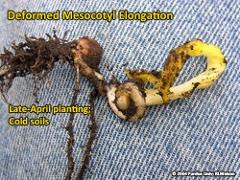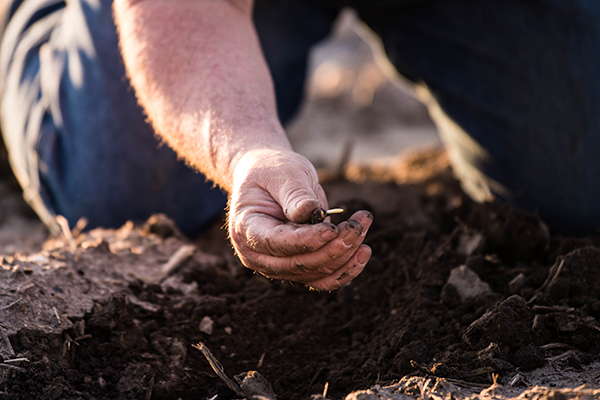AGRONOMICSUPPORT
YOU CAN TAKETO THE FIELD
Cold Imbibition (Cold Shock) in Corn
As I am writing this article, we are on the front end of a major cold front that is going to sweep across most of the corn belt. It is expected to bring with it colder than average temperature’s with rain and snow to the west and north. Planting operations are in full GO MODE in most of the storm track path. I have received numerous calls over the last day or so from growers questioning whether they should continue to plant or hold off until the front passes.
The biggest concern is a drop of soil temps in the top two inches. Cold imbibition, cold chill imbibition, or cold shock are all terms used to describe the same affects caused to seedlings. Soil temperatures regulate whether seeds will germinate or not. The ground temperature needs to be 50 degrees Fahrenheit for a corn seed to start the germination process. During the first 24 to 48 hours the seedling imbibes, or absorbs, water and swells. During this process if the soil temps drop below 50 degrees Fahrenheit for an extended period, or if the seedling simply absorbs cold water, it can cause major issues. The absorption of cold water causes cell membranes to rupture in seedlings and can alter germination, vigor, and emergence. All of this in turn can lead to reduction is stand establishment.
Symptoms of cold shock can vary. Most of the time the symptoms are corkscrewed or twisted sprouts. Often the sprouts are an off-color of white or yellow. In some cases, you even when you see the symptoms above, the plant will emerge. But the damage is often already done, and the plant simply lacks energy to compete and becomes essentially a weed. Below are some pictures often associated with cold imbibition or cold shock.
Growers should monitor current soil temps and expected weather over the next few days. If current soil temps are border line for germination currently, or if they are forecast for cold precipitation then holding off planting is probably a wise choice.

.tmb-medium.jpg?Culture=en&sfvrsn=2e49d9c6_1)
.tmb-small.jpg?Culture=en&sfvrsn=bdd60306_1)
.tmb-small.jpg?Culture=en&sfvrsn=260b3906_1)
Sources and Additional Information
- https://www.ocj.com/2016/04/corn-germination-and-emergence-processes/
- https://www.agweb.com/article/cold_snaps_shock_corn/
- https://www.agry.purdue.edu/ext/corn/news/timeless/Corkscrews.html
- https://www.agry.purdue.edu/ext/corn/news/articles.12/EarlyCornColdWthr-0412.html






Technical Team Agronomist